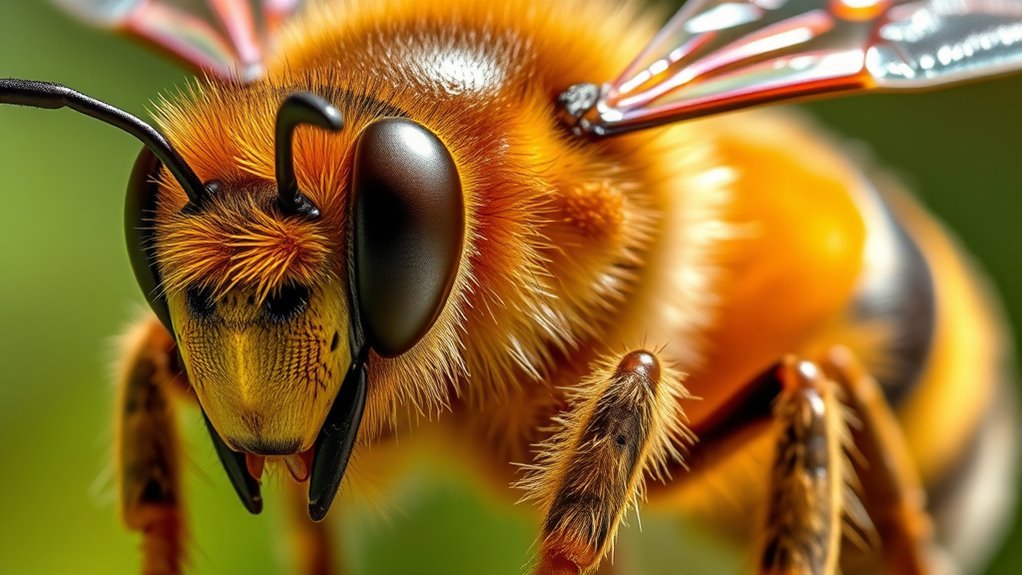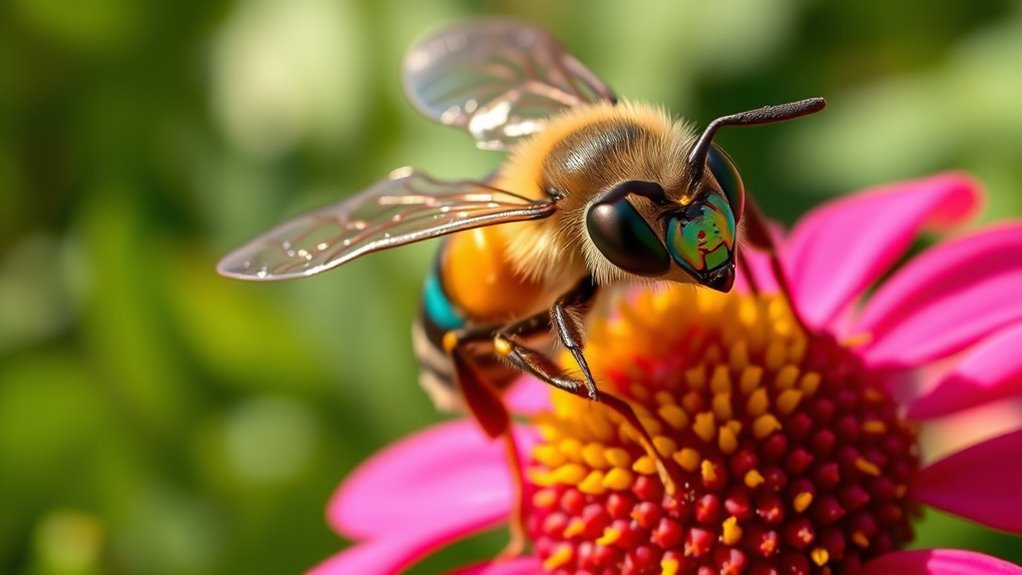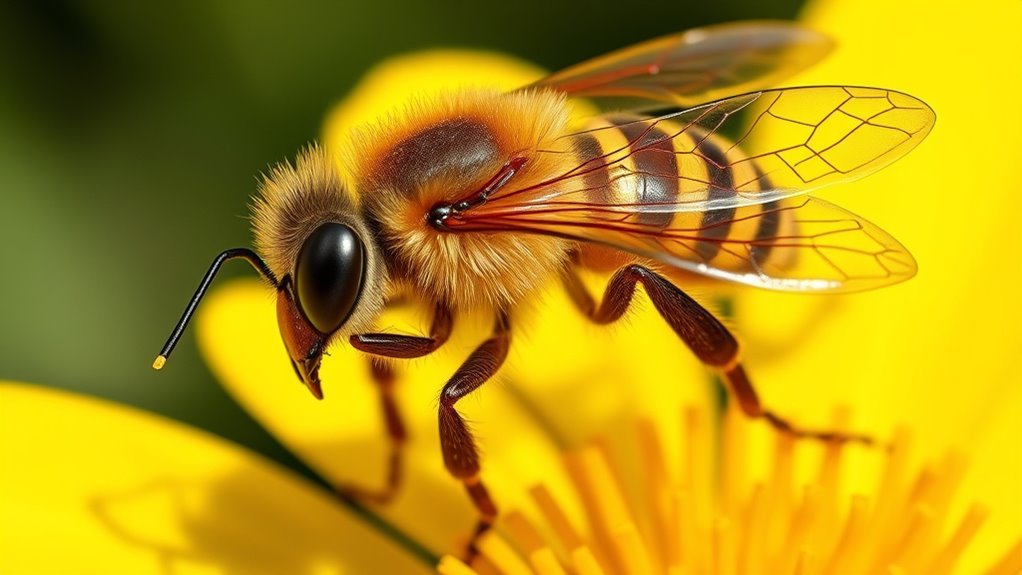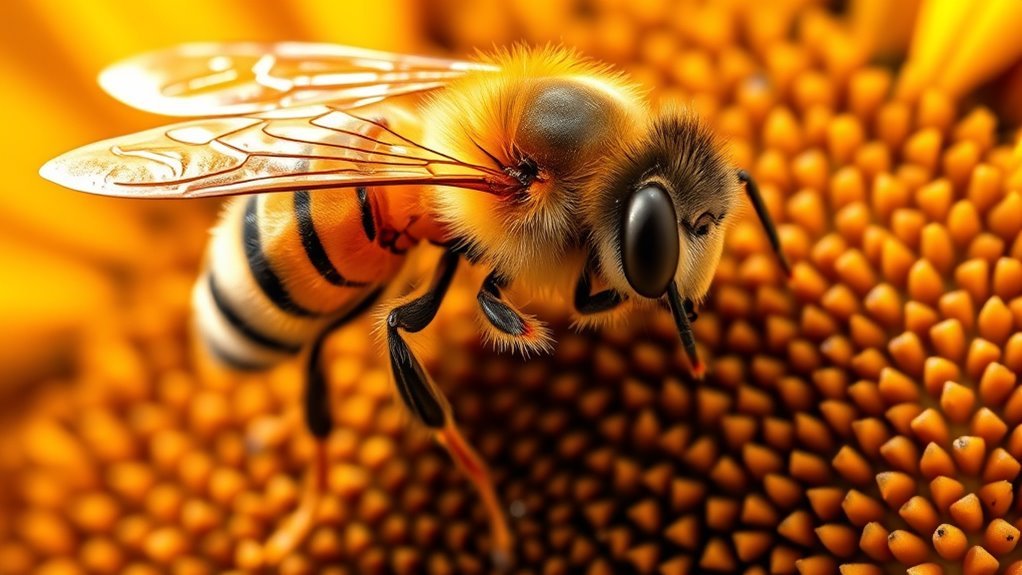Drone bees are larger than worker bees, typically measuring 15 to 17 millimeters. They have robust, rounded bodies and broader wings for agility. Drones exhibit a darker coloration, often black or brown, with simpler markings and shorter hair coverage. Their prominent compound eyes enhance distant vision for locating queens, while they lack stingers. Primarily focusing on reproduction, drones’ lifecycle and behavior are essential in maintaining hive health and genetic diversity. Discover more about their role in beekeeping and colony dynamics.
Physical Characteristics of Drone Bees

Drone bees, the male counterparts of the hive, possess distinct physical traits that set them apart from worker bees and queens. Primarily, their drone anatomy features a larger, robust body, which is vital for their role in bee reproduction. Drones have larger, rounded eyes that enhance their vision, essential for spotting queens during mating flights. Unlike workers, drones lack stingers, which reflects their singular purpose: mating. Their wings are also proportionately larger, aiding in flight agility. Additionally, drones store sperm in specialized organs, demonstrating an evolutionary adaptation for maximizing reproductive success. Understanding these characteristics helps you appreciate the complexity of hive dynamics and the significant role drones play in sustaining bee populations through reproduction.
Size Comparison: Drones vs. Worker Bees

When comparing the sizes of drones and worker bees, you’ll notice distinct differences that reflect their specialized roles within the hive. Drones are generally larger, with an average drone size being about 15 to 17 millimeters in length, while worker bees typically measure around 11 to 15 millimeters. This worker comparison highlights the drones’ robust build, which is necessary for mating purposes. Drones possess a broader abdomen and lack stingers, emphasizing their focus on reproduction rather than foraging or defense. Understanding these size distinctions helps you appreciate the hive’s dynamics and the roles each bee plays. Recognizing these physical traits enables you to identify drones and workers more effectively, contributing to your knowledge of bee behavior and ecology.
Distinctive Coloration and Markings

Coloration and markings play an essential role in distinguishing drone bees from other members of the hive. You’ll notice that drone bees exhibit specific color patterns, typically characterized by darker and less varied hues compared to worker bees. Their bodies often showcase unique color variations that can help you identify them quickly.
| Trait | Description |
|---|---|
| Base Color | Generally darker, often black or brown |
| Banding | Fewer and broader bands than workers |
| Markings | Less intricate patterns |
| Hair Coverage | Shorter, sparser hair |
| Overall Appearance | More robust and rounded |
Understanding these distinctive colorations is key to recognizing drone bees, enhancing your appreciation for their role within the hive.
Eye Structure and Vision
When you examine drone bees, you’ll notice their compound eyes, which consist of thousands of individual ommatidia, enabling a broad field of vision. This unique eye structure allows them to detect movement and polarized light, essential for navigation during foraging. However, their vision range differs considerably from that of worker bees, impacting their roles within the hive and environment.
Compound Eye Anatomy
The intricate structure of compound eyes in drone bees plays an essential role in their ability to navigate and interpret their environment. These eyes consist of thousands of tiny ommatidia, each functioning as a separate visual unit, contributing to overall eye functionality. This design enhances visual acuity, allowing drone bees to detect movement and color with remarkable sensitivity. The lenses of each ommatidium focus light onto photoreceptor cells, which convert the light into neural signals. This complex arrangement enables drone bees to perceive a wide field of vision, facilitating their search for mates and foraging activities. By understanding the anatomy of these compound eyes, you can appreciate how they equip drone bees with essential survival skills.
Vision Range Differences
Although drone bees possess a remarkable compound eye structure, their vision range differs considerably from that of worker bees and queens. Drones have large, multifaceted eyes that enhance their visual perception, particularly in detecting movement. However, their vision range is primarily optimized for distant sight, which aids in locating potential mates during flight. Unlike worker bees, drones lack the ability to perceive ultraviolet light effectively, limiting their visual spectrum. This difference impacts their overall navigation and foraging capabilities, as workers rely on a broader visual range to identify flowers and landmarks. Consequently, while drones excel in certain visual tasks, their specialized vision emphasizes reproductive roles over the thorough environmental awareness seen in their counterparts.
Behavior and Role in the Hive
While drone bees may seem less active than worker bees, their behavior and role within the hive are essential to the colony’s reproductive success. Understanding drone behavior helps you appreciate the intricate hive dynamics. Drones primarily serve as the colony’s genetic contributors during mating seasons, ensuring diversity and survival. They exhibit unique behaviors that set them apart, including:
- Fewer foraging duties compared to workers
- Reliance on worker bees for sustenance
- Engagement in specific mating flights
- Presence during swarming events
- Maintenance of seasonal population levels
These traits highlight that while drones may not be the hive’s laborers, their contributions are critical to the overall health and future of the colony. Their existence embodies the delicate balance of nature’s reproductive strategies.
Mating Rituals and Seasonal Presence
Understanding the mating rituals of drone bees is essential for grasping their seasonal presence within the hive. During the mating season, which typically occurs in late spring to early summer, drone bees engage in specific behaviors that maximize their chances of reproduction. Males congregate in drone congregation areas, where pheromones attract potential mates. This seasonal behavior is critical, as only drones that successfully mate with a queen contribute to the genetic diversity of the hive. After mating, drones usually die shortly thereafter, emphasizing the intensity and singularity of their purpose. Recognizing these mating rituals helps you appreciate how drone bees play an important role in the lifecycle of the colony, ensuring the continuation of their species.
Lifespan and Developmental Stages
The lifespan and developmental stages of drone bees are vital for comprehending their role within the hive. Drones, primarily created for reproduction, undergo distinct phases that influence their longevity and function. Typically, a drone’s lifespan ranges from 8 to 12 weeks, with several key developmental stages:
- Egg Stage: Fertilized by the queen, eggs hatch into larvae.
- Larval Stage: Drones are fed royal jelly and pollen, growing rapidly.
- Pupal Stage: Drones undergo metamorphosis in cells, transforming into adults.
- Adult Stage: Once emerged, drones seek mating opportunities.
- Seasonal Decline: After mating season, drones are often expelled from the hive.
Understanding these stages helps you appreciate the intricacies of drone lifespan and their significant, albeit short-lived, contributions to the colony.
Importance of Drones in Beekeeping
Although often overlooked, drone bees play an essential role in the dynamics of beekeeping. Their primary function centers around drone reproduction, fundamental for maintaining genetic diversity within the hive. Without drones, queens wouldn’t have the opportunity to mate, which directly impacts the colony’s health and productivity. You’re likely to appreciate that drones contribute to hive dynamics through their interactions, influencing worker bees’ behavior and overall colony morale. When you understand the importance of these male bees, you’ll recognize that they’re not just passive participants; they serve as integral components of a thriving ecosystem. Emphasizing the balance between drones, workers, and queens is essential for successful beekeeping, ensuring sustainability and resilience in your apiary.
Frequently Asked Questions
How Do Drone Bees Contribute to Hive Temperature Regulation?
In hive dynamics, drone bees play an essential role in temperature control. They cluster together, generating heat through their body warmth, which helps maintain ideal conditions for brood development and overall hive health during temperature fluctuations.
Do Drone Bees Have Any Natural Predators?
Yes, drone bees face natural predators like wasps and birds. They rely on hive protection strategies, including worker bees’ vigilance, to minimize threats. Understanding these dynamics is essential to maintaining a healthy hive ecosystem.
Can Drone Bees Survive Without a Queen?
Drone bees can’t survive long without a queen. Their lifespan relies on hive dynamics; without her, they lose purpose and support, quickly perishing. Understanding this relationship is essential for grasping bee colony health and sustainability.
What Is the Typical Mating Behavior of Drone Bees?
Drone bees engage in mating rituals during reproductive cycles, typically seeking queen bees in flight. Their behavior emphasizes competition, with multiple drones attempting to mate, ensuring genetic diversity within the hive and promoting reproductive success.
How Do Drone Bees Communicate With Other Bees?
Drone bee communication primarily occurs through pheromones and visual signals, influencing bee colony dynamics. You’ll find that these interactions are essential for reproductive success, helping maintain harmony and ensuring the colony functions effectively during mating seasons.

